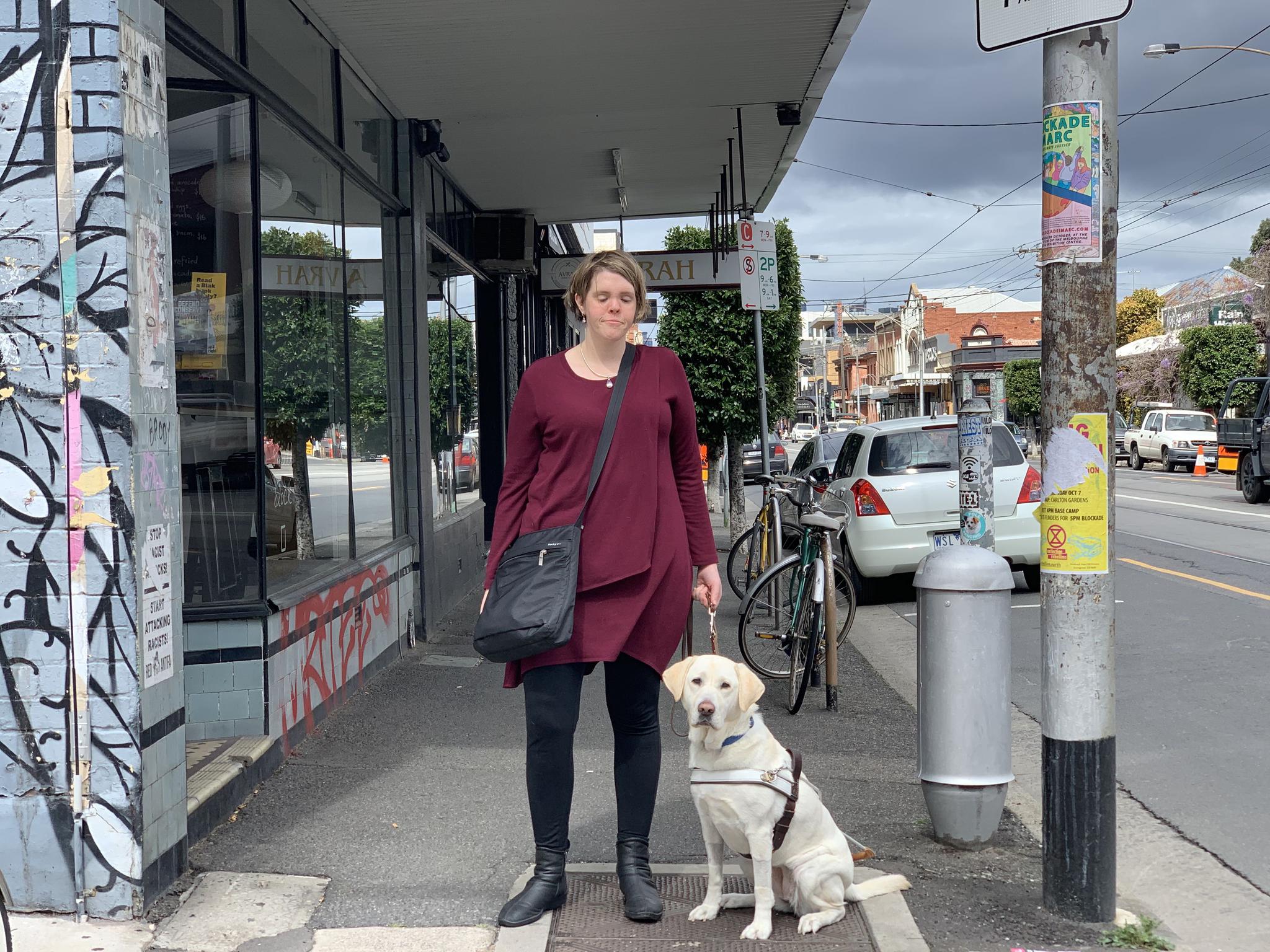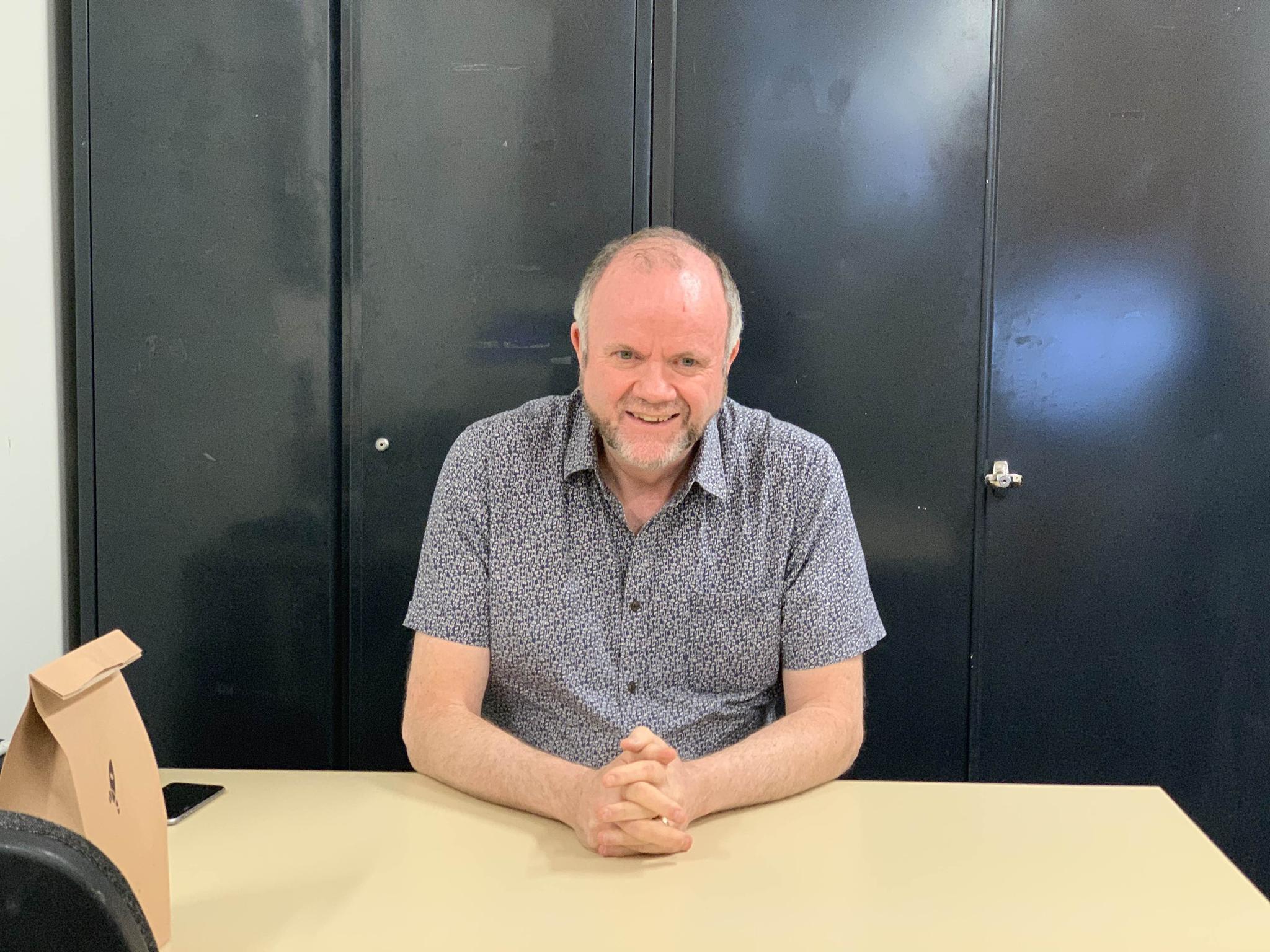Surviving Darkness: What it’s like to lose your eyesight as an adult

Lauren Henley and her guide dog, Valentina
Lauren Henley drove her car to work every morning. Back in 2006, she was a 20-year-old Parks and Gardens apprentice for Newcastle City Council. When she was not playing with chainsaws and ride-on lawnmowers, you could probably find her trying out recipes, playing squash, or hanging out with friends. She was your ordinary girl, independent and challenge-driven, until her car crashed into a telegraph pole and her life turned almost upside down.
“It was like lights on, lights off,” she recalls.
The accident was fatal. Her face smashed the stirring wheel, her eyes ruptured on impact, and just like that, the world goes black. She had lost her sight.
“There were meant to be an airbag, but it didn’t go off.”
Henley was immediately taken to the Emergency Room, with a long list of trauma which includes a damaged face, injured left foot, and dislocated right knee. Soon after, she received a facial reconstructive surgery complete with a fake pair of eyeballs.
What followed was six months of intense grieving period. Henley wasn’t familiar with blindness before, let alone thought about ever losing her vision.
“I was probably as ignorant as other people before I lost my sight.”
She fell into a deep depression to the point that for a while, she did not want to keep living. All she had in mind was ‘What’s my life gonna be like now?’
This went on until a gentleman from Blind Citizens Australia visited her at the hospital. He had lost his eyesight in the 2002 Bali Bombings.
“He basically said to me ‘look, you’ve got two choices: you can sit at home, be miserable, and think about what you don’t have, or you can get out there, live life and be happy’,” his words really got to her, and she remembers thinking, “I don’t really want to be sitting at home for the rest of my life”
Soon, Henley joined Blind Citizens Australia, received the support she needed, and began making her way towards acceptance.
“I started to meet other people that lost their vision and had come out of the other side. To be able to look at someone else, see how they’ve dealt with it, and think ‘I can do it as well’, that’s really powerful.”
Her parents were her number one support. “I’ll never forget my mom’s selflessness, being in the hospital with me, seven weeks in the row”, Henley recalls, her voice soft and sincere. “She never left my bedside,”
“My dad and I used to fight like cat and dog. We never really get along, but this experience had brought us closer together”
Henley learned how to use the cane, picked up Braille, and attended group meetings. But it took her 12 months before she was comfortable going out alone. Her parents were understandably worried, but she knew they would never let that worry stop her from doing anything.
“It freaked my dad out at first, which I think motivated me,” She giggles, remembering her stubborn ways. “He’d be like, ‘You can’t do that by yourself’, and I’ll tell him, ‘Well, yes I can!’”
Henley began working for Blind Citizens Australia not long after. She became President of the Newcastle/Hunter branch, and then went on to become the Policy and Administration Coordinator. In 2014, she participated in the United Nations’ Conference of States Parties to the Convention on the Rights of Persons with Disabilities (CSRPD) in New York. She has come a long way since the accident, and if anything, she has been using her exposure to blindness for good.
A few years back, Henley left Newcastle and moved to Melbourne, where she resides with her Labrador Retriever guide dog, the perky and energetic Valentina.
“I knew as long as I lived near mom and dad, I’m sort of be dependent on them. I wanted them to be able to get on with their lives as well. Here I can just be independent and do what I gotta do,
“It’s just nice spending quality time together, without that being because I need their help.”
Henley currently works as a Policy Officer at Council on the Aging Victoria, as well as running her own consultancy business. She often delivers workshops related to aged care sector and disability awareness training for business in hospitality industry.
Thirteen years after the accident, Henley now thinks of her blindness as “just one challenge after the next”.
“It was a depressing period, but I think I’m the same for the most part,” she remarks, tilting her head to the side.
“Every now and then I find myself thinking ‘What would I be doing if- ‘, ‘What would my life be like,’
“But I think that even if it wasn’t blindness, there’s always something that would bring us down, cause that’s what makes us human.”
-
Speaking of vision loss, Leighton Boyd is a different story. Unlike Henley, he has always known that he would be totally blind one day.
Leighton Boyd does not look blind at all. He is tall and well for his 66 years of age. He has blue eyes that stare at you during conversations, and would even touch your elbow as he talks.
But that’s just because he is not completely blind, yet.
Boyd has Retinitis Pigmentosa, a progressive hereditary retinal disease. It is a genetic eye condition that causes the photoreception cells- part of the retina that catches light- to degenerate slowly.
Retinitis Pigmentosa affects 1 in 4,000 people and is currently the leading cause of youth blindness in Australia, according to the Department of Health Australia.
“Generally, you lose your peripheral vision- the ability to see the sides, and then it will turn into a tunnel vision- only able to look straight ahead. Then it starts to be more like looking through a pinhole,” as Boyd explains.
He is currently the National Chairman of Retina Australia, a non-profit organisation run by volunteers which aims to raise awareness, facilitate support, fund researches, and become source of credible information for Inherited Retinal Disease (IRD).
“It’s like looking from a tiny straw.”
Boyd was diagnosed at the age of 5. His parents had brought him to an eye specialist because he was a bit awkward and clumsy, often tripping over things. After a series of tests, doctors concluded that he has Retinitis Pigmentosa.
Having diagnosed in childhood, Boyd learned from an early age to always make adjustments.
“At school, maybe I didn’t see the board properly, or played sports but did not quite see the ball,” Boyd went to normal schools and have never learned braille. “I just make adjustments along the way. I sit in front and always have my back towards the window.” He describes.
Boyd was trained in electronics but worked most of his life as a judges’ associate in the family court. He would sit in court, read papers and review cases. He started with normal prints, and then move towards bigger prints, darker prints, and eventually bold prints.
He worked for 15 years before his vision got worse and was superannuated out for disability. He was satisfied regardless, because to him, “It’s better to get the job and then finally lose it, rather than to not get a job at all.”
Boyd married his wife Rosemary at 21 years old.
“When we got married, he still could see a lot better than he does now. His vision hasn’t deteriorated like in the recent years,” recalls Rosemary.
“She’s lucky she’s married to me,” Boyd laughs, his eyes widen. “You’ve got to believe that, you’ve got to be positive.”
Rosemary and her family knew that Boyd has this disease. But as Rosemary sums it, “You take people for who they are, not because they have an eye disease.”
Their two children are perfectly sighted and understood their fathers’ disease from early on. “That’s just something that’s been part of their lives, something they’ve accepted,” Rosemary remarks. In a lot of ways, she is happy that it made them more tolerant of others. “It’s been a good thing.”
Speaking of her children, she remembers that her neighbour used to envy their tidy house. “The children know they have to pack up because if daddy gets home and steps on the toy, it might be broken, or he might hurt himself.”
For the family, adjustments are made all the time. The lights are always on in their house, even during the day, because Boyd has always been night blind.
Rosemary eventually becomes Retina Australia’s company secretary, often accompanying Boyd on conferences overseas.
Boyd has been a volunteer for Retina Australia since 1987. Part of his job is to talk to parents who consult with him about their children.
“When a parent called and say that their eight-year-old has got Inherited Retinal Disease, I’ll usually tell them stories about myself and other people.
“There are people with this disease, who trained as doctors and then gone into physio. There are lawyers. Just because we are losing our vision, doesn’t mean we can’t think. We got other skills,” he says in a very reassuring manner.
“I said ‘watch your child, make adjustments so that your child can have a good life’.”
To help further studies on Retinitis Pigmentosa, Boyd and his family sent their blood samples across continents. Although promising treatments like gene and stem cell therapies are being developed, researchers are still struggling to find a cure.
Nonetheless, aside from continuing to work advocate for people with Inherited Retinal Disease, the Boyds hope to travel and “see a bit of the world that we haven’t seen”, as Rosemary put it.
“The good thing about Leighton, and people who have had vision, is that you can talk about colours, distances, mountains, or buildings, they sort of know what they look like.”
When travelling, Rosemary would take the role as the couple’s eyes and describe everything she sees to her husband.
His previous ability to see is also what Boyd is most grateful for. “I’ve been able to see my family and friends, able to really see their faces and watch them grow up.
“I think the secret to losing vision is that we have to be positive. And it’s a little bit of a cliché, but there’s always people worse than us.
“Yes, it’s frustrating, but it’s not the end of the world,” Boyd says as he leans back on his seat, smiling.

Leighton Boyd, National Chairman of Retina Australia
0 Comments Add a Comment?